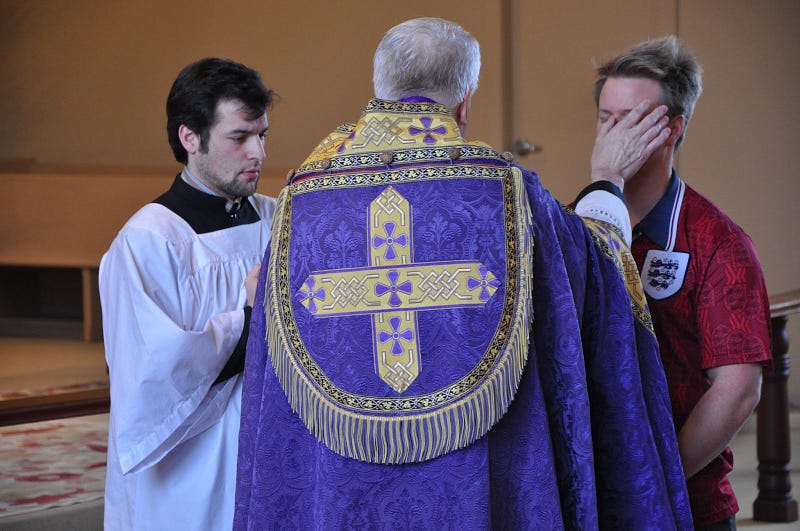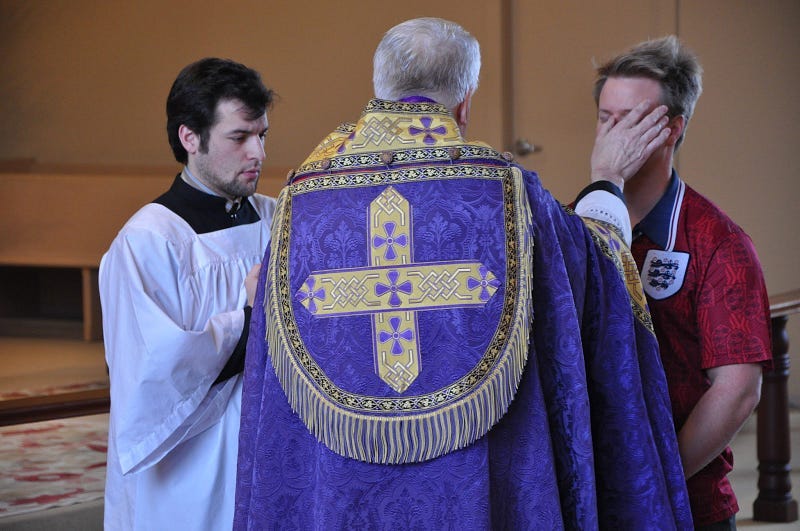Can Deacons Cope?
No, I am not wondering whether deacons can personally cope with the demands of ministry. Instead, I want to take a look at when deacons may…
This article has been updated to reflect the 2024 edition of Holy Communion and Worship of the Eucharistic Mystery Outside of Mass.
No, I am not wondering whether deacons can personally cope with the demands of ministry. Instead, I want to take a look at when deacons may wear the liturgical garment known as a cope.
A cope is a large cape-like garment worn by sacred ministers for liturgical celebrations outside of the Mass. I started thinking about copes a couple of years ago during diaconal formation when my former pastor remarked that deacons would be well advised shop for copes over dalmatics when purchasing vestments.
Here was his reasoning: A dalmatic to a deacon is what a chasuble is to a priest. It is the vestment worn at Mass. For the most part, priests and/or parishes will have dalmatics to match the priest’s chasuble, so most deacons won’t have much reason to own their own dalmatics. Any time the deacon might be acting as the principle celebrant of a liturgy it will always be outside of the context of a Mass — weddings, funerals, baptisms, public celebrations of the Liturgy of the Hours, etc. — in which case the appropriate liturgical vestment would be the cope.
That seems simple enough. Chasulbe and dalmatics are for Mass. Copes are for other liturgical celebrations. So if a deacon finds himself presiding over Vespers at the parish, or is asked officiate at a wedding, he should grab his cope, right? If only it were that easy. As a newly ordained deacon, I am discovering that the sacred vesture called for in the various liturgical rubrics is not always so straightforward.
Here’s a brief run down of what vestments a deacon may wear according to current liturgical norms in the Catholic Church.
BENEDICTION
Let’s start with Adoration and Benediction, which is a fairly common liturgical occurrence in most Catholic parishes. The rubric regarding vestments comes from Holy Communion and Worship of the Eucharistic Mystery Outside of Mass (92), which states:
The minister, if he is a Priest or Deacon, should wear an alb or a surplice over a cassock, and put on a white stole. In accordance with local custom, he may also wear a white cope… Furthermore, when imparting the blessing at the end of adoration, when the exposition takes place with a monstrance, both Priest and Deacon wear a while cope and humeral veil; if a ciborium is used, still they wear a humeral veil.
BAPTISMS
How about at Baptisms outside of Mass? There are various places in the Rite of Baptism for Children that describe the proper vesture (35, cf. 74, 107, 165), all of which prescribe the same thing:
…the priest or deacon, vested in alb or surplice, with a stole (with or without a cope) of festive color…
Again, this is pretty straightforward. Whether priest or deacon, the minister of baptism may wear a cope if desired.
FUNERALS
The same holds true with funerals. According to the Order of Christian Funerals (182):
The minister who is a priest or deacon wears an alb with stole (a cope may be used, if desired)…
SOLEMN BLESSINGS
A deacon or priest is not going to vest every time a parishioner asks him to bless a rosary. But for more solemn blessings celebrated with a community, a sacred minister should vest, and in these cases a cope is appropriate. According to the General Introduction of the Book of Blessings (36):
A priest or deacon when presiding at blessings celebrated communally, especially those that are celebrated in a church or with special solemnity, is to wear an alb with stole. A surplice may replace the alb when a cassock is worn; a cope may be worn for more solemn celebrations.
COMMUNION SERVICES
Things start to get different when we look at Communion services as described in Sunday Celebrations in the Absence of a Priest. When a deacon is leading such a celebration because of the unavailability of a priest to offer Mass, this is how he is supposed to vest (42):
When a Deacon presides at a Sunday celebration in the absence of a priest… [h]e wears the vestments proper to his ministry, that is, the alb with stole and the dalmatic.
No mention of the cope. Instead he wears the dalmatic, which is the deacon’s normal vesture for Mass. This is not Mass. It is a Communion service. But perhaps because of the centrality of the Eucharist to both, the same sacred garment is prescribed.
Similarly, Holy Communion and Worship of the Eucharistic Mystery Outside of Mass gives the following instruction for vesture worn while distributing Communion outside of Mass (20).
The minister of Holy Communion, if he is a Priest or Deacon, should be vested in an alb, or a surplice over a cassock, and should wear a stole.
So again, no cope.
WEDDINGS
The same logic doesn’t apply to weddings, however, which makes the new norms regarding diaconal vesture when presiding at weddings outside of Mass quite strange. Last year, a new ritual book for weddings was promulgated. Prior to this latest edition, the proper vesture for the presiding deacon was a cope (although many wore the dalmatic illicitly). The new norms from The Order of Celebrating Matrimony 80 (cf. 83) are:
At the appointed time, the Priest, wearing an alb or surplice, and a white or festive stole, and even a cope (or a dalmatic for a Deacon) of the same color…
Some are reading this as “copes for priests, dalmatics for deacons.” In other words, the deacon is not be permitted to wear a cope when officiating at weddings. This would be oddly inconsistent, given that copes are permitted for funerals and baptisms. But this is how some are interpreting the text, which admittedly does say that a priest wears alb/surplice with stole and “even a cope.”
My feeling is that when the above rubric says “priest” what is intended is “minister” which would include priests or deacons. I base this off of the rubric immediately above this statement, №79, which reads:
When Mass is not celebrated, either by necessity or because of circumstances, the order described here is used, even by a Deacon.
In other words, the rite presumes the presiding minister is a priest, but allows for a deacon, in which case the deacon would do what the priest would do and wear what the priest would wear. If you look at №80 again, you’ll note it also says the priest should wear alb or surplice with a stole, but makes no mention of the deacon. But surely the deacon would wear the same, as this is the basic vesture at any liturgical celebration, whether or not a cope is worn. (In the former edition of the ritual, the same held true. The rubric prescribing vesture only used the word priest, even though deacons could legitmately preside. They were assumed to wear the same vesture in that case — alb/surplice, stole, with optional cope).
So I think I’m safe in interpreting the new rubric to mean that a priest or deacon should wear alb/surplice and stole, with or without a cope, with the deacon given the additional option of the dalmatic in place of the cope. Essentially, this new rubric is legitimizing a formerly illegitimate practice when it comes to dalmatics for weddings. But why? As stated above, the dalmatic is the Eucharistic vestment of the deacon. And a wedding is not Mass.
LITURGY OF THE HOURS
Finally we come to public celebrations of the Liturgy of the Hours. Sadly, this may not be something many deacons regularly preside over, but in my case I lead a weekly Sung Vespers with my college students, so I’ll be doing this more often than anything else.
Whenever I have been to a public celebration of the Liturgy of the Hours presided over by a priest, he’s been vested in a cope, so I presumed it would be the same for a deacon. Nope.
The rather confusing instruction from the General Instruction of the Liturgy of the Hours (255) is:
The priest or deacon who presides at a celebration may wear a stole over the alb or surplice; a priest may also wear a cope. On greater solemnities the wearing of the cope by many priests or of the dalmatic by many deacons is permitted.
A plain reading of this rubric indicates that the cope is an option for a presiding priest, but a presiding deacon is specifically not given this option. However, if there are many deacons involved in the liturgy, they may wear dalmatics.
And if they are assisting a celebrating bishop then, according to the Ceremonial of Bishops (192), “deacons may wear either a cope or dalmatic” for major solemnities, but should be “vested in alb and dalmatic” for simpler celebrations (CB 207).
Why the cope, which any ordained minister may wear when presiding at baptisms, weddings, funerals, Benediction, and solemn blessings, would be denied to deacons when presiding over Lauds and Vespers (but allowed when assisting the bishop) is beyond my ken! But that’s what the instruction indicates.
IN SUMMATION
In the end I don’t really have grave concerns over deacons being able to wear the cope in this or that situation. As a deacon, I’m going to wear what the liturgical rubrics permit, one way or the other. I only wish there were greater consistency in what was worn when. It seems simple enough to say “dalmatic at Mass; otherwise a cope.” But it’s apparently not that simple. The deacon must familiarize himself with the rubrics of whatever specific liturgy he is participating in or presiding over and vest accordingly.
According to current liturgical norms, this would be the dalmatic for Mass, Communion services, and weddings; a cope (even if optional) for baptisms, funerals, benediction or solemn blessings, and (though some disagree) weddings; and stole over alb (surplice) only when presiding over public celebrations of the Liturgy of the Hours, but cope or dalmatic when assisting a bishop (and presumably a priest) celebrant.




